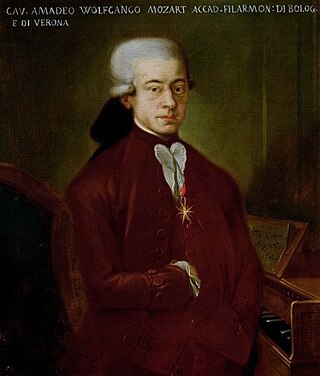Violin Concerto No. 3 (Mozart)
Violin concerto by W. A. Mozart From Wikipedia, the free encyclopedia
The Violin Concerto No. 3 in G major, K. 216, was composed by Wolfgang Amadeus Mozart in Salzburg in 1775 when he was 19 years old. In a letter to his father, Mozart called it the "Straßburg-Concert". Researchers believe this epithet comes from the motive in the third movement's Allegretto in the central section, a local dance that already had appeared as a musette-imitating tune in a symphony by Carl Ditters von Dittersdorf.[1][2]
| Violin Concerto in G major | |
|---|---|
| No. 3 "Straßburg-Concert" | |
| by Wolfgang Amadeus Mozart | |
 Mozart in 1777 | |
| Key | G major |
| Catalogue | K. 216 |
| Composed | 1775 |
| Movements | Three (Allegro, Adagio, Rondeau) |
| Scoring |
|
Instrumentation
The work is scored for solo violin, two flutes (second movement only), two oboes (tacet in the second movement), two horns in G and D, and strings.
Movements
Summarize
Perspective
The piece is in three movements:
I. Allegro

The Allegro is in sonata form, opening with a G major theme played by the orchestra. The main theme is a bright and happy discussion between the solo violin and the accompaniment, followed by a modulation to the dominant D major, then to its parallel key D minor. It experiments in other keys, but does not settle and eventually, heads back to the tonic, G major, in the recapitulation.
II. Adagio

The second movement is in ternary form in the dominant key of D major. The orchestra begins with the main theme, which the violin imitates one octave higher. The winds then play a dance-like motif in A major, which the violin concludes. The violin restates the main theme in A major, although the melody features A sharp instead of A natural, creating a brief modulation to B minor. It soon modulates back to A major, then to the home key of D major through the main theme. After the cadenza, the violin plays the main theme again, thus concluding the movement in D.
This is the only movement in the five violin concertos by Mozart where a pair of flutes are used instead of oboes.
III. Rondeau

The finale is a rondo in G major and in 3
8 time. Mozart inserts into the rondo a short G minor Andante section followed by a longer G major Allegretto section, both in cut time.[3]
Recordings
References
External links
Wikiwand - on
Seamless Wikipedia browsing. On steroids.
